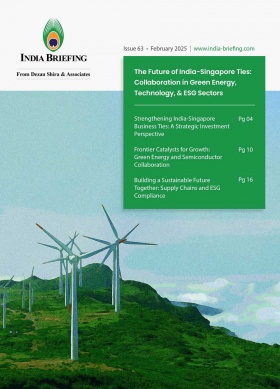India Mulls Opening Key Government Procurement Market to Foreign Companies
India is considering partially opening its central government procurement market to foreign companies, including US firms, according to media reports dated May 23, 2025. The move is reportedly under discussion between India and the US as part of a broader interim trade agreement.
As per several media reports published on May 23, 2025, India is preparing to partially open its tightly controlled government procurement market to foreign companies, including those from the United States (US). In an article published by Reuters, this move follows similar access granted to the UK by India under a recently concluded free trade agreement (FTA).
It must be noted that India’s Ministry of Commerce and Industry has not officially commented on the US negotiations or the potential for broader application of this policy.
Access for US firms for procurement contract under discussion
As of May 2025, India’s central government ministers are negotiating a trade pact with the US administration in Washington, D.C. Reports are emerging that discussions are reportedly underway to allow US-based companies to bid on national procurement contracts in India. These contracts would primarily involve central government projects, while state governments’ and local enterprises’ market procurement will remain off-limits to foreign bidders for now.
India’s total public procurement includes spending by central, state, and local governments as well as state-owned enterprises.
|
*NIC eProcurement Tender Statistics for March 2025 |
|||||
|
S. no. |
Organisation/state |
During the March 2025 |
Up to the month of March in FY 2024-25 |
||
|
|
|
No. of tenders |
Tender value |
No. of tenders |
Tender value |
|
A. |
Central Public Procurement Portal (CPPP) |
||||
|
1. |
Central CPSEs |
3,957 |
INR 225.23 billion |
40,225 |
INR 5.81 trillion |
|
2. |
Central govt. organisation |
3,858 |
INR 609.81 billion |
51,689 |
INR 3.58 trillion |
|
3. |
Defence establishment |
3,791 |
INR 52.56 billion |
59,183 |
INR 551.28 billion |
|
4. |
PM Gram Sadak Yojana |
1,108 |
INR 189.51 billion |
9,038 |
INR 469.94 billion |
|
B. |
Major central public sector enterprises & Defence PSUs |
||||
|
1. |
Coal India Limited |
3,023 |
INR 6.34 billion |
27,759 |
INR 185.01 billion |
|
2. |
Bharat Heavy Electrical Limited |
1,134 |
INR 8.19 billion |
12,111 |
INR 93.92 billion |
|
3. |
NTPC |
752 |
INR 1.72 billion |
10,251 |
INR 76.58 billion |
|
4. |
Indian Oil Corporation |
446 |
INR 170.54 billion |
7,835 |
INR 676 billion |
|
5. |
Defence PSUs |
200 |
INR 1.72 billion |
2,373 |
INR 35.19 billion |
|
6. |
Chennai Petroleum Corp Ltd |
31 |
INR 520 million |
468 |
INR 7 billion |
|
C. |
States and union territories (31) |
159,521 |
INR 2.19 trillion |
1.6 million |
INR 14.10 trillion |
|
Grand total |
(A+B+C) |
177,821 |
INR 3.45 trillion |
1.8 million |
INR 25.60 trillion |
Source: Central Public Procurement Portal (CPPP) Newsletter, March 2025.
*NIC refers to the National Informatics Centre, a central government entity.
Public procurement tenders in India are largely reserved for its domestic players, with 25 percent of contracts earmarked for small businesses. It may be noted that certain sectors in India, like defense and railways, allow foreign procurement when domestic alternatives are unavailable.
Public procurement is the process through which government bodies and state-owned enterprises acquire goods and services from private vendors to meet their operational needs. Similar to private companies, government departments require a range of supplies and services—from office equipment to infrastructure development—to function effectively.
India uses CPPP—a digital platform where tenders from central ministries, departments, and public sector enterprises are published for market procurement. Through this portal, registered businesses can view and bid on government contracts.
Precedent set by India-UK trade deal
On May 6, 2025, India signed an FTA with the UK that included a provision granting British firms access to a specific central government procurement market. This access spans goods, services, and construction contracts and is offered on a reciprocal basis.
READ MORE: India-UK Free Trade Agreement Finalized
UK companies are expected to gain the right to compete for a defined portion of contracts, especially in construction, goods, and services. While specifics are pending, the agreement signals a shift towards more inclusive participation.
The deal would also extend preferential treatment to UK firms under India’s “Make in India” policy. UK companies with at least 20 percent domestic content could be classified similarly to Indian suppliers, allowing them better standing in central procurements. Those sourcing 50 percent or more from India may qualify for top-tier supplier status.
In India’s public procurement, supplier status classifies vendors based on the local content in their goods or services, affecting their eligibility and preference in government tenders:
- Class-I local supplier: 50 percent or above local content; gets top preference.
- Class-II local supplier: 20–50 percent local content; eligible but lower priority.
- Non-local supplier: Less than 20 percent local content; generally ineligible unless no local bids qualify.
Selective market opening
India, however, has confirmed that under the agreed FTA, UK suppliers will be limited to bidding on domestic contracts deemed Class-II local suppliers and only in non-sensitive sectors.
On February 18, 2022, India opened the government procurement segment to the UAE under the Comprehensive Economic Partnership Agreement (CEPA). Under that pact, UAE firms are allowed to participate in procurement tenders in India worth over INR 2 billion (US$23.44 million).
India lobbies for favorable trade agreement with the US
India’s Union Minister of Commerce and Industry, Piyush Goyal, traveled to the US on May 16, 2025, to advance discussions, with both sides aiming to finalize an interim trade agreement by early July. This timeline coincides with a 90-day pause on tariff hikes announced by US President Donald Trump on April 9 for major trading partners, including India. One of the key issues for US negotiators has been India’s historically restrictive procurement framework, which the US Trade Representative criticized in its March 2025 report as a barrier for American businesses.
Balancing MSME concerns in India
Despite the policy shift, the central government is reportedly considering measures to protect its domestic industry. As per media reports, the secretary general of the Federation of Indian Micro, Small, and Medium Enterprises (FISME) has assured that the central government will reserve 25 percent of public procurement orders for the small industry. Bhardwaj had emphasized that opening the procurement market to foreign firms on a reciprocal basis could create new opportunities for Indian exporters to access international government tenders.
India has traditionally resisted joining the World Trade Organization’s Government Procurement Agreement, citing the need to shield its small-scale industries. However, the new approach signals a willingness to explore bilateral frameworks that allow for limited and mutually beneficial access to public contracts.
Role of the Central Public Procurement Portal (CPPP)
To streamline and standardize the public procurement process at the central level, India has established the CPPP. This portal serves as a centralized platform for all central government departments, public sector enterprises, autonomous bodies, and other agencies to publish tender notices, contract awards, corrigenda, and related procurement information.
One of the key objectives of the CPPP is to provide a single-window access to procurement activities across different ministries and departments, making the process more accessible and transparent.
Procurement across central government ministries
Various ministries under the central government participate in public procurement, such as the following:
- Ministry of Defence
- Ministry of Home Affairs
- Ministry of Housing and Urban Affairs
- Ministry of Petroleum and Natural Gas
- Ministry of Railways
Each ministry or department typically operates its own finance or procurement division, which is responsible for managing the procurement processes. These divisions act as the primary point of contact for vendors seeking to engage in government tenders. While the structure and role of these procurement wings may differ between central and state governments, their function remains fundamentally similar.
(US$1 = INR 85.30)
About Us
India Briefing is one of five regional publications under the Asia Briefing brand. It is supported by Dezan Shira & Associates, a pan-Asia, multi-disciplinary professional services firm that assists foreign investors throughout Asia, including through offices in Delhi, Mumbai, and Bengaluru in India. Dezan Shira & Associates also maintains offices or has alliance partners assisting foreign investors in China, Hong Kong SAR, Vietnam, Indonesia, Singapore, Malaysia, Mongolia, Dubai (UAE), Japan, South Korea, Nepal, The Philippines, Sri Lanka, Thailand, Italy, Germany, Bangladesh, Australia, United States, and United Kingdom and Ireland.
For a complimentary subscription to India Briefing’s content products, please click here. For support with establishing a business in India or for assistance in analyzing and entering markets, please contact the firm at india@dezshira.com or visit our website at www.dezshira.com.
- Previous Article 全球贸易格局变动之际,印度制造业有望实现增长
- Next Article India’s AI Infrastructure and Emerging Market Leadership: An Outlook







